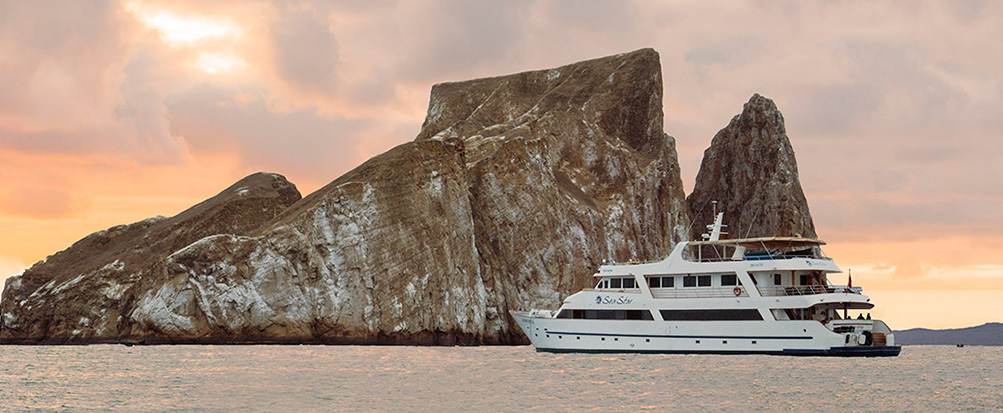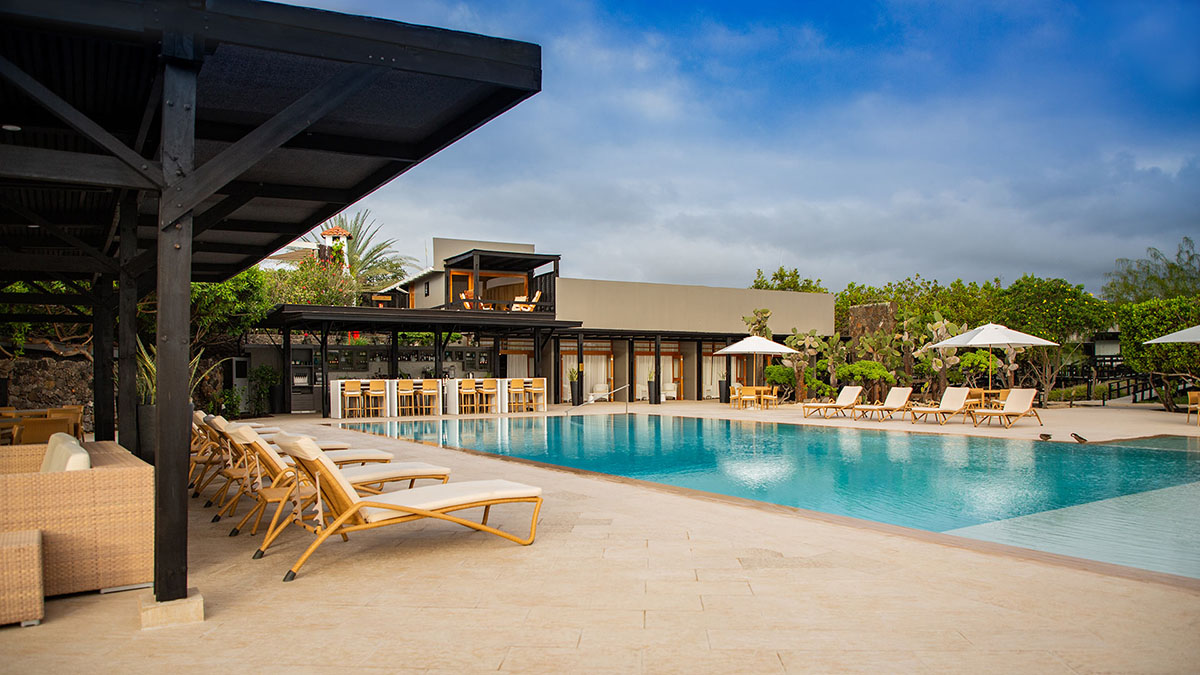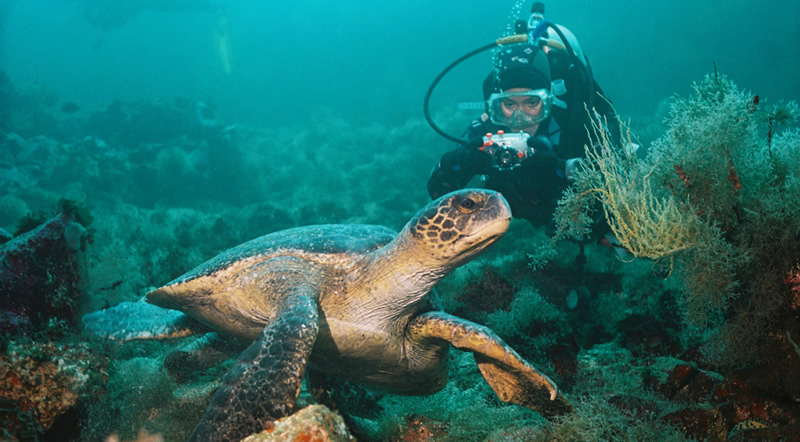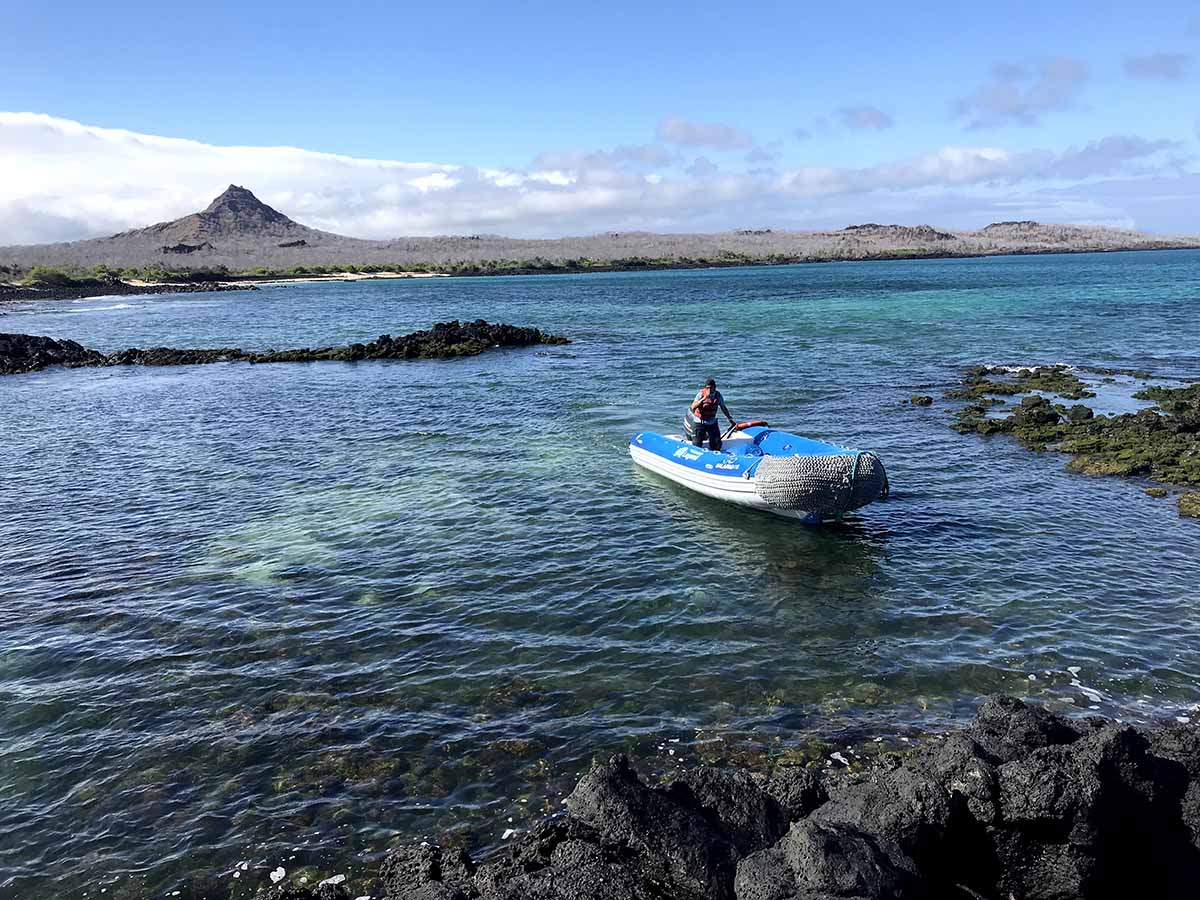
In the Galapagos, 97% of the land and 100% of the marine habitat are protected by a national park, so traveling to this archipelago isn’t like any other island destination. How to best explore and where you can and cannot go is a mystery for many first-time Galapagos goers. You have two options: book a Galapagos cruise or land tour. While the destination is the same, a cruise versus taking a land-based tour from one of the port towns are quite different experiences.
Galapagos cruises are time efficient, allowing you to travel further and see more of the islands, all while staying on an all-inclusive ship. Land tours offer guests more flexibility in start dates and itineraries, but are restricted in how far they can travel. Plus, sleeping on land prevents seasickness overnight. Learn more about the pros and cons of each, questions to ask yourself, and which option might suit you best below.
Galapagos Islands cruises are generally regarded as the best way to see the Galapagos Islands . Waking up in a new destination each morning, incredible all-inclusive service from the crew, and reaching remote destinations are among the best perks of Galapagos cruise packages .
And, if you are looking for a luxury Galapagos tour , look no further than our favorite cruise ships .

The Galapagos Legend cruise ship. Photo by Maribell Mormontoy of Peru for Less.
Continue to the next section to learn more about land-based tours. Cruising is not your only option for a vacation in the Galapagos Islands .

Sea Star cruise ship in the Galapagos. Photo by Latin Trails.
Land tours, also referred to as island hopping or land-based packages, include sleeping in a hotel on one of the main islands and visiting different nearby islands each day to explore. All Galapagos adventures offer an unrivaled opportunity to spot wildlife in their natural habitat. However, like cruises, Galapagos land tours have specific benefits and drawbacks to consider when planning your trip.

Finch Bay Hotel, a top hotel on Santa Cruz Island. Photo by Finch Bay Hotel.

Golden Bay Hotel on San Cristobal Island. Photo by Golden Bay Hotel.
Keeping your preferences in mind, what is the best way for you and your travel buddies to explore the Galapagos ? The following questions address specific interests and common concerns that many visitors have that can further help you determine if a Galapagos cruise or land-based exploration is best for you.
Galapagos Tours:
The Galapagos consist of 6 main islands, 12 smaller islands, and over 40 islets, all teeming with rich natural wonders. To explore the protected regions of this national park, even travelers on a land-based tour must travel by boat from port towns to designated spots to explore. For this reason, any traveler prone to seasickness – whether on a Galapagos cruise or land-based tour – should pack some sort of motion sickness remedy.
If you or someone in your travel group is prone to getting seasick, then a land-based tour might be the safest option. A land-based Galapagos tour gives you more wiggle room for independent discovery, so if you decide to skip out on a boat tour, you can decide instead to go to the beach or visit a tortoise reserve. Plus, you don’t have to worry about rocking motion at night and the fear of waking up seasick.
Groups that are set on taking a cruise, yet still concerned about some of their travel companions getting seasick, should consider traveling to the Galapagos between the months of January and May when the waters are most calm. July through September is when the cold Humboldt Current arrives and brings rougher conditions. Larger cruise vessels (not small yachts or sailboats) are more stable, which can also help with seasickness.
Smallest chance of seasickness: Land tour.

A land iguana on the Galapagos. Photo by Maribell Mormontoy of Peru for Less.
Both cruise and land-based tours offer unique opportunities to get within arm’s reach of sea lions, ocean-going lizards, 500-pound giant tortoises, and so much more. Yet aboard a Galapagos cruise you cover more distance and wake up in a new destination each morning. With greater exposure to more sites throughout the islands, it stands to reason you see more diverse wildlife and creatures at sea as a cruise passenger. Animal activity in the Galapagos varies island-to-island as well as month-to-month.
Best wildlife spotting: Cruise.

Red-footed boobies, a seabird living in the Galapagos. Photo by Maribell Mormontoy of Peru for Less.
Mid-sized cruising vessels, small yachts, and sailboats are all-around comfortable (and surprisingly upscale), from cabin accommodations down to the selection of onboard amenities and services. However, all of these sea-based tour options fall under one common setback: limited space.
Staying in a Galapagos hotel on a land-based tour of the Galapagos gives you a bit more privacy and comfort to spread out. Unlike a cruise, travelers who stay in a hotel can even wander off the grounds, experience the local community, and explore parts of the island itself in their down time.
More personal space: Land tour.

Sea lions live across the Galapagos Islands. Photo by Jackman Chiu on Unsplash .
Travelers whose lifelong dream is to snorkel in the Galapagos can do so on a cruise or land-based tour. Flippers, masks, and wet suits are available to rent, but water lovers who want to scuba dive need to be PADI certified and plan their trip accordingly.
Most Galapagos diving tour s are organized for land-based travelers on the islands of Santa Cruz, Isabela, and San Cristobal . Those planning on cruising must plan an extra day before or after their cruise to coordinate a dive. Scuba divers know to wait at least 24 hours after diving before flying to avoid decompression sickness. Because of this, the best option is to coordinate diving excursions before starting a cruise. Strong currents in the Galapagos can make some dive sites challenging, so previous experience is an absolute must!
Extreme divers may also choose a diving specific, liveaboard cruise. These cruise options tend to last one week or more and feature 1-4 dives each day.
Snorkeling: Either Galapagos cruise or land tour.
Diving: Land tour or diving specific cruise.

Diving in the Galapagos reveals an impressive underwater world.
If you have specific vacation dates or you’ve already purchased your airfare, then obviously you have some planning limitations. Cruise companies schedule their itineraries months in advance and have set departures going on different routes every 4 to 8 days. If you have a specific ship and/or itinerary in mind, it is necessary to coordinate your travel plans with the ship’s schedule. However, of the many Galapagos cruise ships , several depart each day.
There are significantly more itinerary and hotel options available each day on land based tours. Nonetheless, contact our team of Travel Advisors to see what options are available to you.
Set dates: Land tour, but check if any cruises also fit your dates.

Dragon Hill on Santa Cruz Island. Photo by Monique Loayza of Peru for Less.
Most cruise cabins comfortably fit two adults or two adults and one child. Some connecting rooms are available, but these are not common, especially on smaller ships. Hotels on the islands offer more flexible rooming options for Galapagos family trips and large groups.
1-2 people per room: Either Galapagos cruise or land tour.
3 or more people per room: Land tour.

The underwater views in the Galapagos are full of schools of fish, sea turtles, and sometimes even sharks and whales!
Natural history that inspired Charles Darwin, beautiful landscapes, wildlife like no other, and adventure collide in the Galapagos Islands, making it one of the world’s most magical destinations. Check out our comprehensive Galapagos Travel Guide and contact us to plan a custom itinerary. Which answers your call to adventure: Galapagos Cruise or Land Tours ?



Email: [email protected]
Sign up to receive our newsletter for great articles, stunning photos, and special deals.